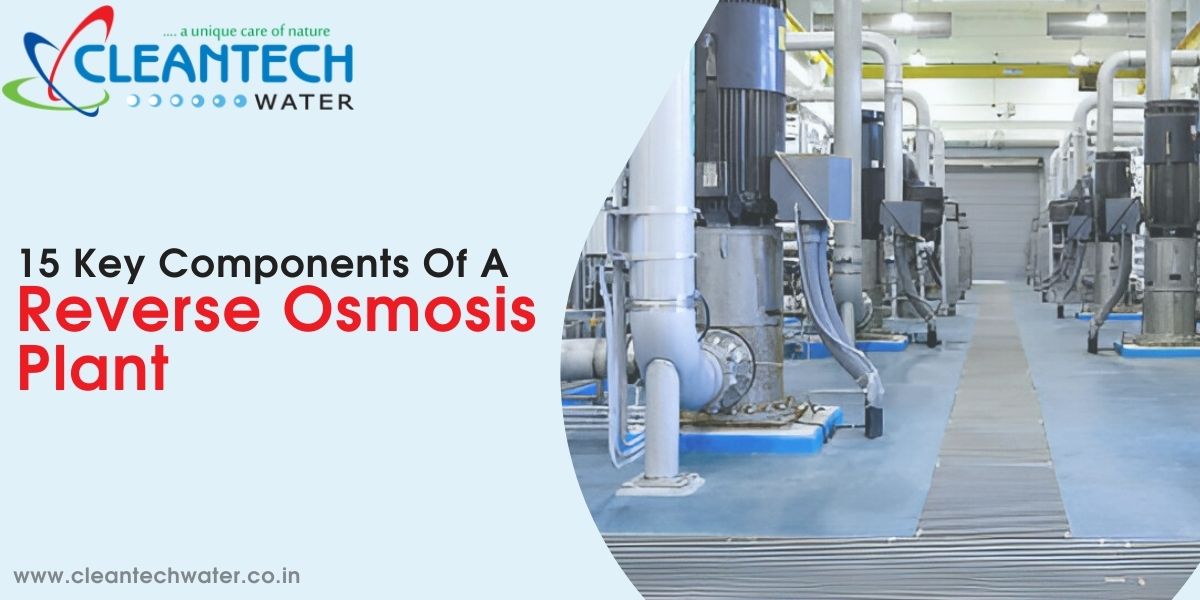Water scarcity and contamination are significant concerns globally, and India is no exception. Access to clean and safe drinking water is essential for public health and well-being. Reverse Osmosis (RO) plants have emerged as a popular solution for addressing water quality issues, especially for property owners. In this guide, we explore the key components of an RO system, understanding their functions and importance in ensuring the delivery of clean and safe drinking water.

15 Important Components of a Reverse Osmosis Plant
1. Feed Pump of an RO System
The feed pump serves as the heart of an RO system, playing a crucial role in pressurising the feed water. This pressurisation is necessary to force the water through the RO membrane, facilitating the separation of contaminants from the water. The selection of an appropriate feed pump is critical as it determines the flow rate and pressure levels within the system, directly impacting its efficiency and performance. Factors such as water source characteristics and system design should be considered when choosing the right feed pump for a reverse osmosis plant.
2. Multimedia Filter
Pre-treatment of water is essential to protect the RO membrane and enhance the overall efficiency of the plant. The multimedia filter is a vital component in this pre-treatment process. It consists of multiple layers of media, including sand, gravel, and anthracite, designed to remove suspended solids, sediment, and larger particles from the water. By effectively filtering out these contaminants, the multimedia filter prevents clogging and fouling of the RO membrane, thereby prolonging its lifespan and ensuring consistent system performance. Routine maintenance and replacement of media are necessary to maintain the effectiveness of the multimedia filter.
3. Antiscalant Dosing System
Scaling, caused by the precipitation of mineral salts, is a common issue in reverse osmosis plants, particularly in areas with hard water. The antiscalant dosing system is employed to mitigate scaling and extend the operational life of the RO membrane. It introduces specialised chemicals into the feed water that inhibit the formation and accumulation of scale on the membrane surface. Proper dosage and monitoring of the antiscalant are essential to prevent scaling-related issues, such as reduced permeate production and increased energy consumption. Regular testing of water quality parameters and adjustment of dosing levels are necessary to ensure optimal performance.
4. Micro Filtration Units
While the RO membrane is highly effective in removing dissolved solids and contaminants from water, it may not adequately address certain types of particulate matter, including bacteria and viruses. Microfiltration units serve as an additional barrier against these microorganisms, ensuring the production of microbiologically safe drinking water. These units typically consist of fine filters with pore sizes ranging from a few microns to sub-micron levels, capable of trapping bacteria, viruses, and other microorganisms. Regular cleaning and maintenance of microfiltration units are essential to prevent biofouling and ensure the quality of treated water.
5. System Pump
The system pump is integral to the functionality of a reverse osmosis plant. It is responsible for pressurising the feed water and pushing it through the RO membranes. This pressure is essential for the separation of contaminants from the water, ensuring only purified water passes through the membrane pores while impurities are retained. Selecting the right system pump is crucial to maintaining optimal pressure levels and achieving efficient filtration.
6. Pressure Vessels
Pressure vessels accommodate the RO membranes and provide the necessary environment for the filtration process to occur. These vessels are designed to withstand high pressures and contain multiple RO membrane elements. The number of pressure vessels required depends on factors such as water flow rate and feed water quality. Proper maintenance of pressure vessels, including regular cleaning and inspection, is essential to ensure the longevity and performance of the RO system.
7. The RO Membranes
The RO membranes are an indispensable component of a reverse osmosis plant, responsible for separating dissolved solids and contaminants from the feed water. These semi-permeable membranes allow water molecules to pass through while blocking larger molecules such as salts, minerals, and microorganisms. The quality and efficiency of the RO membranes directly impact the purity of the treated water. Regular performance monitoring and timely replacement are essential to maintain optimal filtration efficiency.
8. Post Treatment
After passing the RO membranes, the treated water goes through post-treatment to increase its quality. This may include processes such as remineralisation, pH control, and disinfection to ensure that the water meets regulatory standards and is safe for consumption. Post-treatment also helps improve the taste and overall aesthetic qualities of the water, enhancing the user experience.
9. Unfailing Devices in the RO System
Fail-safe devices are critical components designed to safeguard the RO system against potential malfunctions and emergencies. These devices may include pressure relief valves, flow meters, and automatic shutdown systems that activate in the event of abnormal operating conditions such as excessive pressure or flow rates. By implementing these devices, property owners can mitigate risks and ensure the safety and integrity of their reverse osmosis plant.
10. Monitoring Instruments in the RO System
Businesses or individuals investing in reverse osmosis plants must understand the crucial role of monitoring instruments in ensuring the efficient operation and performance of their systems. Let’s explore these instruments in detail:
- Low-Pressure Gauge: The low-pressure gauge in an RO system monitors the pressure level on the feed side of the membrane. It provides valuable insights into the system’s operating conditions, indicating whether the feed water pressure falls below the recommended range. By monitoring the low-pressure gauge, property owners can detect potential issues such as clogged filters or pump malfunctions, allowing for timely intervention to prevent system downtime and damage.
- Flow Meters: Flow meters measure the rate of water flow through the RO system, providing real-time data on water production and consumption. These instruments help property owners monitor system performance, track water usage and detect any deviations from normal operating conditions. By accurately measuring flow rates, flow meters enable property owners to optimise system efficiency, identify leaks or malfunctions, and ensure the consistent delivery of purified water.
- High-Pressure Gauge: The high-pressure gauge in an RO system monitors the pressure level on the permeate side of the membrane. It indicates the pressure exerted by the purified water as it passes through the membrane, ensuring that it meets the desired quality standards. Monitoring the high-pressure gauge helps property owners maintain optimal operating conditions, prevent membrane damage due to excessive pressure, and maximise the efficiency of the reverse osmosis plant.
- Total Hour Run Meter: The total hour run meter records the cumulative operating time of the RO system. It provides property owners with valuable information on system usage and helps track maintenance intervals and service schedules. By monitoring the total hour run meter, property owners can schedule routine maintenance tasks such as filter replacements, membrane inspections, and system cleaning, ensuring the long-term reliability and performance of their RO systems.
11. Pressure Control Valve of the RO System
Pressure control valves play a critical role in regulating the pressure levels within the RO system, ensuring optimal operating conditions and membrane performance. These valves maintain a constant pressure differential across the membrane, preventing fluctuations that can impact filtration efficiency and system reliability. Properly adjusted pressure control valves help optimise system performance, minimise energy consumption, and extend the lifespan of RO membranes.
12. Piping across the RO System
The piping network across the reverse osmosis plant facilitates the flow of feed water, permeate, and concentrate streams between various components. High-quality piping materials and proper installation are essential to prevent leaks, minimise pressure drops, and ensure the efficient transfer of water throughout the system. Regular inspection and maintenance of piping systems are necessary to identify and address any potential issues that may compromise system performance or integrity.
13. Skid or Container of the RO System
The skid or container of the RO system serves as the structural framework that houses all system components, including pumps, membranes, instrumentation, and piping. It provides support, protection, and ease of transportation for the entire system, ensuring stability and durability in various operating environments. The design and construction of the skid or container should meet industry standards and regulatory requirements to ensure safety, reliability, and compliance with installation guidelines.
14. Pre-treatment Equipment
Pre-treatment equipment plays a crucial role in preparing the feed water for the RO membrane filtration process. This equipment includes various components such as sediment filters, activated carbon filters, and water softeners. Sediment filters remove suspended particles and debris from the water, preventing clogging and damage to downstream components. Activated carbon filters remove chlorine, organic compounds, and other contaminants that can affect membrane performance and lifespan. Water softeners reduce the concentration of dissolved minerals, such as calcium and magnesium, which can cause scaling and fouling of the RO membranes. Proper pre-treatment ensures the feed water meets the required quality standards and extends the life of the RO system.
15. Clean-in-Place (CIP) System
A Clean-in-Place (CIP) system is essential for maintaining the cleanliness and integrity of the RO membranes and associated components. It consists of pumps, tanks, and piping dedicated to the automated cleaning and disinfection of the RO membranes. Regular CIP procedures remove accumulated fouling, scale, and biofilm from the membrane surfaces, restoring their performance and efficiency. Proper CIP protocols also help prevent microbial growth, extend membrane life, and ensure consistent water quality. Implementing a CIP system as part of routine maintenance practices is critical to maximising the longevity and reliability of your reverse osmosis plant.
Ready to Improve Water Quality? Contact Us for Expert Reverse Osmosis Solutions!
Frequently Asked Questions (FAQs)
Why is pre-treatment necessary for an RO system?
Pre-treatment is essential for an RO system because it helps remove suspended particles, organic compounds, and dissolved minerals from the feed water. These contaminants can clog RO membranes, reduce filtration efficiency, and increase maintenance requirements. By implementing pre-treatment equipment such as sediment filters, activated carbon filters, and water softeners, property owners can protect their investment in an RO system and ensure consistent water quality.
How often should the Clean-in-Place (CIP) system be used?
The frequency of CIP procedures depends on factors such as feed water quality, system usage, and operating conditions. Generally, it is recommended to perform CIP cleaning on an RO system every few months to remove accumulated fouling, scale, and biofilm from the membrane surfaces. However, more frequent cleaning may be necessary in environments with high levels of contaminants or microbial activity.
Can I install an RO system myself, or do I need professional assistance?
While some homeowners may attempt to install an RO system themselves, commercial property owners essentially need to hire professionals to establish their reverse osmosis plant. Proper installation is crucial for ensuring the efficiency, reliability, and longevity of the system. Professional installers have the knowledge, experience, and equipment to properly size, configure, and install an RO system according to specific site requirements and regulatory standards.
How can I determine if my RO system is operating efficiently?
Monitoring instruments such as flow meters, pressure gauges, and hour run meters provide valuable data on the performance of an RO system. Property owners should regularly check these instruments to ensure that the system is operating within the recommended parameters. In addition, periodic water quality testing can help assess the effectiveness of the RO system in producing clean and safe drinking water. Any deviations from normal operating conditions should prompt further inspection and maintenance to address potential issues promptly.
We Provide Custom Water Treatment Plant Solutions
At Cleantech Water we provide a comprehensive range of custom water treatment plant solutions, installation, and maintenance services. We understand the importance of ensuring water quality and offer tailor-made systems that cater to your specific requirements and budget.
Our team of professionals is committed to delivering excellence every step of the way, from the initial consultation to the final installation and ongoing maintenance. We prioritise your satisfaction and aim to provide you with peace of mind knowing that your water treatment needs are in expert hands. If you’re looking for the best reverse osmosis plant solutions that guarantee pure and refreshing water, don’t settle for anything less than the best. Reach out to
us at +91-9558996411 or email us at info@cleantechwater.co.in to schedule a consultation and start your journey towards unlocking the door to clean, safe drinking water.

